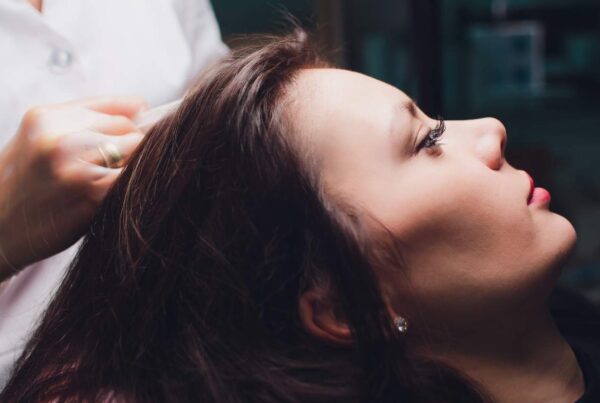The risks of hair transplantation
Hair transplantation is an extremely safe outpatient procedure that is normally without significant risk or complication when performed by a qualified, and certified surgeon. However, as in any operation, there are risks, which are always presented in detail during your personal consultation with the surgeon prior to the procedure.
As in any surgical procedure, an infection can occur. But that’s not all. Patients may also be prone to excessive bleeding, pain, scarring, and, most surprisingly, hiccups.
Hair transplantation is a permanent and lasting solution for many people to remedy hair loss. However, fear of side effects or pain prevents people from taking the plunge. But is this fear really justified? Starks, a clinic specializing in age management and the technique of extracting follicular units, will inform you of the potential risks and explain to you why its fears are unfounded.
Temporary lightening of pre-existing hair
After the operation, some preexisting hair can be thinned. Preexisting hair will return to its normal state a few months after the operation. This phenomenon is however quite rare.
Bleeding
Some bleeding is normal and will stop with a single press. Persistent bleeding occurs in about 1 in 100 cases. Additional stitches are rarely necessary in the case of a FUT intervention, an operation that requires the removal of a strip of scalp from the donor area.
Pains
Patients rarely experience pain during or after the operation. During the intervention, the donor and recipient area is anesthetized locally. Patients, therefore, experience no pain.
Otherwise, post-operative pain is quite minimal. They do not need to take painkillers however if a slight pain is felt, patients may take Doliprane.
Numbness
Some transient numbness is inevitable, usually present in the donor area, it lasts between 3 to 18 weeks. This feeling is rarely bothersome or lasting.
Itching
Itching occurs frequently, but is rarely bothersome and only lasts a few days. Daily shampoo will help relieve this itch.
They are usually caused by the appearance of scabs. However, if the itching is too severe and becomes intolerable, you should consult your specialist or a dermatologist. Hydrating oils exist to relieve this phenomenon.
Swelling
Although this side effect is rare, some patients may experience swelling in the forehead and around the eyes. It usually lasts between 1 and 2 days. In about 1% of cases, a “black eye” can develop.
Infection
Any surgical operation has a risk of infection. In the case of a hair transplant, only one in several thousand patients is affected. However, it is easily treated with antibiotics.
In the case of the FUE method, the risk of infection is rather low. It is however particularly important to respect the standards of hygiene, this is why it is always preferable to call upon an experienced doctor who will explain to you how to make your shampoos well once the transplant carried out. The tiny openings that appear during FUE hair transplant usually heal without complications.
Healing
Keloid scars occur only in predisposed individuals and, even more rarely (one in a thousand), they can cause a wrinkling effect.
Whenever human skin is cut, it heals through a process called fibrosis. This fibrosis (commonly called scar) is the natural process of repairing the skin when it undergoes destruction. Since hair transplant procedures are performed to produce a natural result, the scars in the transplanted areas are usually so small that the fibrosis is almost undetectable. In the case of a FUT, the fine linear scar is masked by the hair which grows back at the back of the skull. In addition, modern suturing techniques reduce the risk of too large a scar.
Otherwise, the FUE hair transplant, a technique used by the Starks clinic, eliminates the risk of a linear scar.
Cysts
One or more cysts can appear in the recipient area when many grafts have been transplanted. They usually go away on their own after a few weeks or immediately with various simple treatments. They are usually no more than 2 or 3 mm in diameter, the size of small buttons.
Hiccups
It may sound strange, but hiccups are a common side effect of hair transplant surgeries. It has been noted that this side effect affects 5 in 100 patients. The cause is not known, however. These hiccups can last from several hours to several days.
Like any surgical operation, hair transplantation (FUE or FUT) involves certain risks and side effects. However, it is important to reassure yourself: they are minimal and do not happen often. Before any intervention, our specialized surgery will inform you about these risks and help you take preventive measures to reduce the chances of them appearing. Finally, let us also remember that hair transplantation is one of the safest and least disabling cosmetic surgeries that exist. The day after the operation, you can resume your normal life. You just need to take a few precautions, especially in terms of the first shampoos and the care to apply to precisely limit the majority of side effects such as the risk of infection, itching, pain and bleeding.
If you are interested in hair transplantation, go to the Starks website, the clinic that takes care of your hair.
Thanks for viewing this post. Starks currently provides age management solutions in clinics located in France, Greece and Italy. Please click below to read this article in one of these languages.
- French: Les risques de la greffe de cheveux
- Italian: I rischi del trapianto di capelli




